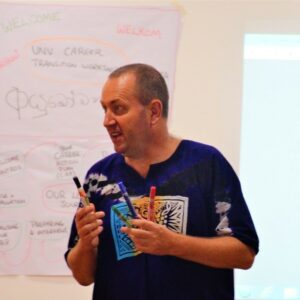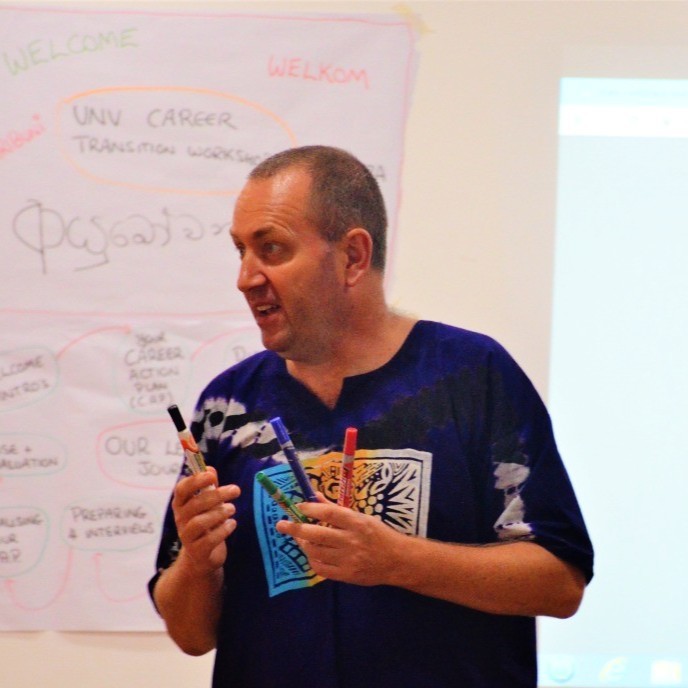Demographics
Who is facilitating and where?
Education & Experience
What backgrounds do facilitators have?
Welcome to the second edition of SessionLab’s
State of Facilitation report.
Read on for essential information and expert insights on what is changing in the world of facilitation and workshop design.
The path to professional facilitation in 2024 requires becoming literate in the use of digital tools while cultivating the heart of the craft: relationships, trust, and human connection.
Read on to see what facilitation was like in 2023 and what that can teach us about the promises and challenges of 2024.
2nd edition
975 respondants
93 countries
372 hours filling the survey
Who is facilitating and where?
What backgrounds do facilitators have?
Who do facilitators work for?
What was it like to facilitate in 2023?
What challenges are facilitators experiencing?
What tools do facilitators use?
How do facilitators keep learning?
Welcome to the second edition of the State of Facilitation report!
This year’s data is based on the generous contributions of 975 facilitators across the world who took the time to fill out our comprehensive survey.
Their responses are accompanied by commentary from 12 experts sharing their perspectives.
In 2023, the State of Facilitation survey has undergone some transformation, as we learnt and integrated feedback from participants and readers.
Here are the main changes we’ve made to the State of Facilitation project in 2023:
Aiming for greater inclusion, we added the option of responding to the survey in Spanish. 7.5% of respondents chose to answer in Spanish.
In your own words. You will find direct, anonymous, quotes from survey respondents in both English and Spanish throughout the text.
We added more checkbox questions and reduced the number of open-ended ones. Possible answers were chosen by aggregating responses from 2023. Anything above 1% made the cut.
New questions were often inspired by readers’ requests. We’ve added questions to explore disabilities, environmental practices related to facilitation and more.
Prefer to download the report?
If you prefer to download the report in PDF format, leave your email here to receive it in your inbox! You’ll also receive SessionLab’s facilitation newsletter and get updates about the next survey too!
Before we jump in, a word of caution:
To collect responses we reached out to our networks, colleagues, business partners, and friends.
We did our best, but inevitably that reach is limited. A majority of responses reached the survey through our own channels, such as SessionLab’s facilitation newsletter. This may help explain certain aspects of the data we’ve collected, for example overrepresentation of European and North American responses.
Help us widen our reach in the next edition by joining in and reaching out to your networks.
A growing number of digital tools is transforming facilitation practices (remote and in-person). Digital tools can help design sessions, improve interactivity, and more. It is the era of digitally-assisted facilitation.
We will remember 2023 as the year AI came into our lives and workplaces. Facilitators are turning to AI to speed up, refine and enhance certain aspects of their work. Read on to find out how!
We will also remember 2023 as the year in-person workshops and events came back roaring. At the same time, remote and hybrid facilitation are definitely here to stay. How are facilitators distributing their work? More on this below.
A rising trend is to enlist facilitators to support teams to adapt to fully remote work, hybrid work and/or return to the office. Team building and team support were central topics of facilitation sessions this past year.
The core skills of facilitation are mostly picked up on the job, through learning-by-doing (69.9%) and observing experienced practitioners at work (40.8%).
Work opportunities are mainly sourced by word-of-mouth (55.9%) and referrals from other facilitators. Numerous findings in the report point to the importance of being active in a community of peers to learn, practice and upskill in facilitation.

We received responses from 93 Countries. 40.1% of responses came from the European continent and 31.4% came from North America.
We are glad to see facilitation represented all over the globe. At the same time, we must acknowledge a lack of representation of the Global South and, in particular, Asia in this data.
We hypothesize that this is to be attributed in part to the limited reach of our survey. But even with that caveat in mind, data shows that work still needs to be done to build bridges among different facilitation communities and improve diversity and inclusion practices across the industry.
69.5% of participants responded that “white/European descent” best describes them. If we aggregate all the other responses, which also includes people who self-describe as of mixed, multiracial, biracial ethnicity, only 26.2% of respondents remain. With this data, we can see a clear underrepresentation of non-white, non-European folks in facilitation.
Despite the obvious limitations of such breakdowns, we think it’s important to keep asking the facilitation community this question in order to capture some idea of the level of diversity and representation (or lack thereof!) in the profession.
Respondents to the survey are overwhelmingly working in English, which appears to be the language of most, if not all, international events and work. Facilitation does happen in other languages, with 10.9% of respondents working in Spanish, 7.5% in French, and so on.
25.8% of entries noted that they work in more than one language (in most cases two, of which one was commonly English).
Similar to last year’s edition, the data indicates a scarcity of facilitators under the age of 30 (3.8%) and of people who identify as beginners.
In response to last year’s findings, various organizations have been making extra efforts to include, involve, and train Gen-Z facilitators.
Is it that people tend to come to facilitation later in their careers or that younger people are missing opportunities to join the profession? In any case, let’s continue to find ways to nurture and support the next generation of facilitators!
Last year’s finding about the prevalence of women in the facilitation world led to many lively discussions in the global community. Is facilitation socially understood as a caring profession and, therefore, gendered? What is “feminist facilitation”?
Has the emergence of facilitation enabled more women to move into conventionally male-dominated spaces? How can we keep the space welcoming to all? While the data has not changed much from last year, we are sure such questions keep resonating.
Are two thirds of Facilitators really of White/European descent? It seems unlikely and, in our experience, not at all the case. However, any survey represents those who responded to it. Participation in certain communities, such as SessionLab or the IAF, may influence the survey responses.
On a positive note, compared to the previous year’s report, there is an increase in the representation of countries from Africa, South East Asia, and the Middle East, indicating a broader geographical inclusion in the survey findings.
It is crucial to recognize the need to make efforts to include colleagues from more diverse backgrounds and regions, and for communities to connect with one another more. Sharing across diverse backgrounds can be extremely enriching for all those involved and we urge everyone in the facilitation community to keep working in this direction.
Regarding gender representation, the report suggests that there may be a higher number of women facilitators. It highlights the ongoing discussions within the global community about the perception of facilitation as a “caring” profession and explores concepts like “feminist facilitation” and the potential for facilitation to create opportunities for women in traditionally male-dominated spaces.
Continued exploration of gender diversity within the field is also necessary. At the same time, it is important to approach this finding with caution, as the difference in numbers could be influenced by factors such as survey participation rates among male facilitators.
While the report mentions that English remains the dominant language of facilitation, it also recognizes the presence of multilingual facilitators. Approximately 11% of respondents worked in Spanish, and 7.5% worked in French, indicating the utilization of different languages in facilitation.
In our experience, we’ve also seen facilitators using two or more languages at a time. For example, in East Africa, you frequently find facilitators using a mix of local languages, Kiswahili and English in their workshops.
Similar to the previous year’s findings, there is a scarcity of young and beginner facilitators. This might reflect a lower response rate from younger facilitators or a perception that their facilitation work is not considered as such or taken seriously at a younger age.
This underscores the importance of making efforts to involve and train younger facilitators, recognizing their potential and nurturing the next generation of facilitators.
In conclusion, the document acknowledges the significance of inclusion, diversity, and representation within the facilitation community. It emphasizes the fact that as a global community, we need to expand outreach efforts, include colleagues from various backgrounds worldwide, and create an inclusive and supportive environment for facilitators.

Member of IAF Social Inclusion Special Interest Group and Freelance Facilitator, based in Mombasa, Kenya

Irene Maweu, Facilitator, IAF Member and founder of the "The Heart of African Facilitation", based in Malindi, Kenya
John Kingsley Cornwell and Irene Maweu
In the past year we have noticed a growing interest around the topic of disability and facilitation. We’ve seen many conversations on social media or in communities about how to best include people with a disability in facilitated sessions. This may be a reflection of a wider societal discussion around inclusion, though it might also be attributed to the pandemic years of almost exclusively remote facilitation.
Working remotely can have a positive effect on inclusion. More accessible online events, updated job designs and closed caption technology to help participants with hearing loss follow an online conversation are some examples of this.
As far as we know, nobody had previously asked how many facilitators identify as having a disability themselves. About 20% of respondents identified as having a disability. Are our gatherings, communities and events designed to include them?
We hope this increased visibility encourages the community to continue opening conversations about the experiences of facilitators and participants with disabilities. If we can better surface the needs of disabled folks and ask for their advice as a community, we can create a more inclusive and accessible space for all.
With approximately one in five people in the world having a disability, it is not surprising that about 20% of survey respondents identified as having one as well, mainly neurodiversity (9%) and chronic health conditions (7%). Neurodivergent people, for example, bring their creative, out-of-the-box thinking to their work, as well as a keen eye for detail and recognising patterns in group dynamics. Those are all very useful skills in facilitation.
Facilitators have a unique opportunity to create truly inclusive spaces and benefit from the diversity of the group. They can do so by building empathy with the access challenges that their participants might face, planning for accessibility in the earliest development stages, and removing obstacles to participation whenever possible.

Facilitator, trainer and accessibility geek. She builds solutions that give team leaders the confidence and the tools to design inclusive and accessible collaboration processes.
Marie Dubost
In this second edition of the State of Facilitation survey, we added the possibility of responding directly in Spanish, which 7.5% of respondents chose to do.
This coincides with Spanish being the fourth most spoken language in the world with around 7-9 % of the world population speaking it.
The Spanish-speaking countries represented by the respondents in the survey are: Argentina, Bolivia, Chile, Colombia, Costa Rica, the Dominican Republic, Ecuador, El Salvador, Mexico, Peru, Spain, Uruguay and Venezuela.
While responses provided in Spanish did not greatly differ from the rest of the world, we did notice numerous references to IIFACE, a professional organization that provides training and accreditation in Spanish, and the popularity of the Latin American Association of Facilitators ALFA (Asociación Latinoamericana de Facilitadores).
More than 6000 languages are spoken around the world, most of them are in quite a difficult state to endure into the future. Around 43% of the world population speaks more than one language to a certain degree (English is the most common second language). All of this demonstrates that there is a dire need to make facilitation available to a larger part of the world where these skills are not yet widespread. There is still a lot to be done.
Facilitating in your native tongue is quite a different experience from facilitating in a second language. It changes your perception of others, the way you communicate, the way you understand, it can change even the way you provide instructions to simple exercises. If you are up to the challenge, get a colleague that can support you in this endeavor of facilitating in a language other than your own, you may experience an expansion of your own borders.

Facilitator and trainer working throughout Latin America. Co-author of The Power of Facilitation, founder of Proyectum and FacilitacionVirtual.com
Héctor Villarreal Lozoya

How does one become a facilitator?
Data shows that facilitation is learned on the job, picked up informally, and strikingly often is not a certified or accredited skill for those who work with it.
Read on to find out more about what this means for individuals wanting to learn facilitation, for potential clients, and for the profession as a whole.
According to respondents to this survey, learning-by-doing is the main path for picking up facilitation skills.
Courses and training (in-person) are the main source of learning for only 14% of respondents. Less than those who reported being participants in other facilitators’ events and workshops as the best place to learn facilitation skills.
24.6% of facilitators learnt by shadowing a more experienced colleague, which is interesting to note as this is how a craft is traditionally picked up.
For some people, facilitation is a profession. For others, it’s seen as an art or a skillset. Based on the above, perhaps the word craft is in fact more accurate to describe it.
It is not surprising to see that as a service profession with a complex set of skills, facilitation is mostly practiced by people who have completed advanced education degrees.
It is worthy to note that there are few opportunities to study facilitation at a degree level. The data appears to show that highly skilled, educated people become facilitators after first working in another capacity or profession.
It is sobering to see such high percentages of people who do not have any accreditation or training certificates related to facilitation in their background. “None” is the most common answer by far.
There is also little awareness among facilitators of the difference between accreditation and certification. Accreditation is a process (think tests and interviews) attesting that the holder has achieved a certain level of proficiency. A certification is usually intended as proof that the holder has taken a course or training program, which may or may not include an element of practice.
Besides learning on the job, facilitators take many short training courses in specific tools or methodologies, but far less frequently do they invest in accreditation programs such as the IAF’s Certified Professional Facilitator, or take courses that cover facilitation skills as a whole.
Are these programs not well-known enough? Do people not see the value in them? If we look at the state of things from a client’s point of view, it’s quite confusing to have a professional milieu with no clear way of telling who is qualified to do the job and who is not. As one participant in the survey commented, certification as a requirement is a possible road for facilitation to grow as a profession. Could the lack of a clear learning pathway also account for the low number of young people in the profession?
We hope these considerations will spark a lively debate in the facilitation community about the value of training, certification, and accreditation, both in terms of professional development and of recognition of the profession.
Meeting facilitation is a required part of many roles in my agency. Training is often on the logistics, and technology. It is rarely on the human element of facilitating.
In order for the field of facilitation to grow and move out of the lower paying arena - it must be recognized as a bonafide profession - certification as a requirement is a key way to do that.
I have always found it fascinating that the world of facilitation and training does not require a level of demonstrated learning, certification, or supervision, unlike coaching.
Could it be because clients do not seek a certificate when they assess who they work with? In my experience clients are wanting demonstrated experience and knowledge.
There are many of us supplying training for facilitators and trainers. It’s not all certified, and I question if the certification is 100% required as we all know a certificate does not make a good trainer!
But how to get started or know if you are developing the right skills?
In my opinion a great facilitator and trainer has a blend of the following:
If you are considering facilitation and training as a line of work and in the corporate world here are four steps you could take

Founder of School of facilitation Facilitator, Trainer of Trainers, Coach to freelance Facilitators and Trainers, Host of A Facilitator’s Journey podcast
Kirsty Lewis
It’s true that nowadays certification can be recognised by some companies as proof of skills, but is it really? Is certification enough to be a good facilitator?
It clearly depends on what is needed to obtain it. Because to me, practice is key!
There are many great facilitators out there who can’t afford to obtain a certification, but who have learned so much on their own journey, that they use in their facilitation work and make them unique.
What is your background? This is always the first question I ask the facilitators I meet or my guests on the podcast: they all have such rich and different backgrounds and I can name on the fingers of one hand those who have put forward a certification.
Wouldn’t it be better, rather than a certificate, to teach facilitation methods from an early age, at school or university or even during holiday camps, so that this soft skill becomes a strong skill and enables them to lead discussions, make decisions and, in the future, help teams work better together.
These young people are naturally and implicitly trained in communication technologies, and will learn to use AI as it always existed.
Shouldn’t they be learning how to work together? How to include everyone in a discussion, how to accelerate collective intelligence, how to be in synergy using individual superpowers.
This is what facilitation is about. And this would create a better world!
I sincerely believe that these techniques and methods should be part of their curriculum, whatever direction they take later on.

Founder of La Workshoppeuse, Workshop facilitator, Mentor for Freelance Facilitators and Host of the Podcast There’s a Workshop for That!
Nathy Ravez

What do facilitators’ careers look like? In this section we’ve asked practitioners to tell us more about their work.
Based on responses from last year, we’ve asked practitioners to specify whether they work mainly as freelancers, as part of an agency selling facilitation services, or in-house within a company with a different mission.
Any such breakdown is bound to be imperfect (and, as we will see below, facilitators switch roles frequently in their careers) but it enables us to look more deeply at topics that are specific to each cohort.
Most (42.1%) respondents stated they mainly facilitate as individuals, e.g. as freelancers or consultants. 28.4% work as part of an agency, while 27.1% work in-house, facilitating within a company whose core business is something other than facilitation.
This might be the case, for example, of managers or team leaders who apply facilitation skills to their work, or it might be someone hired specifically to run workshops inside a certain company.
Practitioners of facilitation who work in-house are the group more likely to identify as beginners, presumably because they are adding facilitation tools and skills to other job descriptions.
The question is multiple-answer as this reflects the fact that facilitators will often use different role titles depending on what kind of task they are taking on.
We added entries this year based on aggregating the “Other” responses from last year. One title that emerged from that analysis is that of CEO/founder/business owner (26%). Checking the breakdown by experience points to the fact that these are in many cases of experienced facilitators who have founded their own consultancy business/agency.
The most frequently mentioned titles for in-house roles that include facilitation skill sets are Learning and Development professional (19.9%), Agile Practitioner (8.8%), and HR professional (3.6%).
Seeing these stats points to facilitation being an important skillset for any organization seeking to build a culture of learning, create innovation and develop their people.
8.9% of facilitators are also managers. We expect this already significant number to keep growing as facilitation becomes increasingly recognized as a necessary skill to manage teams in the new world of work.
Like last year’s State of Facilitation report, most respondents are individual facilitators or working for outside agencies, both being hired by their clients. This makes sense given the cost of permanent in-house facilitators. The changing needs of businesses and their employees often require specialization for a short time.
Compared to last year’s report, more respondents this year said they work for organizations of 5,000 or more people. This could indicate large companies are increasingly adopting facilitation practices to keep up with competition and rapidly changing logistics.
I’m surprised to see so few beginners represented in the results. This could be due to beginners having less familiarity with resources and organizations like SessionLab; however, I would imagine the post-pandemic world with return-to-the-office and hybrid arrangements would bring more beginners.
Two examples I can think of are managers who have now become responsible for guiding their staff through new policies and procedures, and fast adapters becoming facilitators to help others catch up.
The titles “facilitator” and “consultant” are more popular than “trainer.” In the past few years, I’ve heard L&D professionals discourage using the term “trainer” since it conjures up ideas of repeating specific steps and specific scripts for groups of people instead of getting groups to participate and answer their questions.
In other words, “facilitating” is helping people find their way forward, and “training” is telling people the way forward. Both are vital in business and the specific term likely comes down to what’s being done (facilitating new marketing ideas vs. training staff to new software).

Senior Consultant for Knowmium in Hong Kong. Facilitator, coach and author of the Hybrid Live Guide.
Robert Kienzle
In this section we zoom in on the careers of people selling facilitation services to others, whether as freelancers or as part of an agency.
If you are reading this report in search of information and inspiration to launch your own facilitation practice, take notice: facilitation is (still) a sector characterized by a high degree of informality.
Networking (57%), word-of-mouth (55.9%) and being referred by a colleague (50.7%) are the most relevant ways of getting new clients. Interacting with colleagues and participating actively in local and/or online communities are absolutely key to starting and maintaining a career in facilitation.
Facilitation is a trust-based business. Beyond the large amount of work coming from networks and referrals, 64.3% of external work comes from repeat clients. This not only indicates the value of ongoing relationships, but also a high sense of satisfaction in the work delivered.
While finding new clients implies a lot of work to build trust, develop relationships and negotiate agreements, it looks like a worthwhile investment in most cases.
The current state of facilitation for freelancers and agencies is that of a trust and relationship-based profession, where it is of utmost importance to invest time in building and maintaining connections.
On the positive side, this means that facilitators who build their reputation and take part in communities can see a return on that investment. On the potentially negative side, a system based on existing relationships can prove difficult to access for beginners. And how about clients trying to find the right facilitator for their needs without a network to lean on?
A breakdown of the type of sector and industry served by respondents returns the image of a flexible skillset that can be, and is, applied practically everywhere, from SMEs (41%) to International organizations (21.7%). Most respondents indicated the non-profit sector as the area in which they provided facilitation services in 2023 (52.6%).
This may be because of an overlap of interests: distributed power and stakeholder engagement practices are at the heart of much facilitation work. It may also indicate that those working in non-profits are more keen to give back to the global community, including by responding to a survey!
When I chat with fellow facilitators about their primary source for acquiring business, the most frequent answer is referrals, word of mouth, or existing relationships, which is reflected in the data. However, many of us spend a disproportionate amount of time trying to attract new, shiny leads through social media (which, let’s face it, can be a huge distraction!).
The evidence is clear: We work in a relationship-driven industry. To increase the number of workshops you conduct in 2024, start leveraging your relationships, asking for referrals, and prioritizing conversations over content creation.
Because word of mouth is a big driver of future bookings, it does pay to invest in creating rave-worthy, results-driven workshop experiences, where your participants turn into workshop evangelists for your work, meaning you can spend less time in business development, and more time doing the work that you love.
Income is multifaceted and heavily influenced by your client’s location/currency, the industries you cater to, and your economic buyers (and their position in the organizational hierarchy). For instance, it’s quite common for Executive Strategy workshops to command higher fees compared to IT system training for frontline leaders.
The key differentiator in earning potential lies in the perceived value of your work, and the power of your brand. If your service is commoditized, like delivering training or workshops using pre-existing methodologies, it’s treated as a commodity, and most likely, you charge a day rate.
However, if you develop intellectual property, processes, and services, and create a powerful brand, you can demand higher, value-based fees.
I think many facilitators limit their potential by solely focusing on workshops. To boost your income, consider expanding your business model to encompass advisory services, coaching, or project work. While we wish our workshops had an immediate impact, often it’s necessary to offer wraparound services, to help sustain change and client results.

Author of The 2-Hour Workshop Blueprint: Design Fast. Deliver Strong. Without Stress; host of the First Time Facilitator podcast and of an on-demand program called Booked Out Facilitator, where she helps you book out five more workshops, for every workshop you deliver.
Leanne Hughes

In this section we will look deeper into the daily lives of facilitators and what their work was like during the year. What were facilitated sessions and workshops like in 2023? Did they take place remotely or in person? What kinds of topics were most requested, and what does that tell us about the profession as a whole?
Direct quotes come from responses to the question:
“How has your facilitation practice changed over the past 12 months?”
One of the inheritances of the global pandemic has been the spread of shorter interventions. The circa 2 hours session is now the most common session length, whether online or in-person.
Facilitators in 2024 must know how to get to the point quickly and deliver value in the arch of a short, sometimes bite-sized, session, as well as how and when to argue for longer interventions.
More pressure to get straight to the point.
I have noticed that people seem to want everything in an hour or less if possible.
Face-to-face practice has become more succinct - more content is covered online in advance, face-to-face is for sharing, discussion and roleplay/practising.
Generally a trend towards shorter interventions.
We no longer run virtual sessions of over 3 hours.
All virtual and usually no more than 2 hours.
Almost all respondents have run sessions in-person and remotely this year. As is to be expected, in-person sessions are less frequent: 46.5% of respondents have shared the same space with their participants a few times of year, while 28.9% have facilitated remote sessions at least weekly.
While people are coming back in person, the trend of more online sessions is growing as well. During the Covid-19 pandemic remote became a necessity. Now, working together remotely is a choice for an alternative form of meeting. When is remote most appropriate, and when not? What is the true value of remote facilitation and where is the true value of meeting in person?
Hybrid sessions, with people joining both remotely and in person at the same time, have seen a small increase. Hybrids were very much an experiment in 2022, while in 2023 a consensus has emerged that hybrid meetings can be productive, but they require an investment in extra resources, staff, and dedicated technology.
In their comments, facilitators have remarked that securing these extra resources is challenging, but also that some companies have made a successful investment in hybrid meetings. Clients with distributed workforces, take heed!
I'm pushing back hard against 'casual' hybrid (not thought through, under-resourced).
Our organization has reopened our offices and some of them have undergone significant renovations. The technology available in our buildings has been upgraded and this has enabled me to facilitate on-site in hybrid, in-person and virtual formats.
Estuve trabajando mucho facilitaciones híbridas, con distintos recursos para garantizar la experiencia sea lo más significativa para cada participante sea la modalidad elegida.
[I've been working a lot with hybrid facilitation, using various resources to ensure the experience is meaningful for every participant, however they choose to join.]
I have had more face-to-face & hybrid sessions. The hybrid is a challenge to get to work well technically.
Curious to learn what facilitators are working on?
The top answer is training courses (69.7%), which require a combination of facilitation and teaching/training skills that appears to be quite common.
Next comes working with teams: from regular team meetings (59.3%) to team building events (57.2%).
Teams returning to the office or navigating the novel practices of all-remote or hybrid work has increased the need for facilitators to work on team cohesion, team agreements and team development. Consciously creating work culture with the support of expert facilitators is helping companies navigate the new work landscape.
Speaking of which, here is SessionLab’s Robert Cserti discussing how to keep your team motivated and engaged on the podcast Startups for the Rest of Us.
More about bringing teams and groups together, rebuilding dynamics.
Persons generally seem to be asking for external assistance with their teams.
More people asking for help with Team Development vs innovation or strategy. Teams are struggling to stay cohesive.
More need for team building and collaboration know-how.
Looking at last year’s data, there seems to be no significant change in how common the practice of co-facilitation is. This makes us wonder whether facilitators tend to work completely alone or if collaborations primarily take place during other parts of the process.
The topic of co-facilitation is also mentioned in response to open questions around facilitation challenges. These responses indicate that it’s seen as an advantage by most practitioners (and a necessity for hybrid work), but hard to organise and pay for.
Co-facilitation is attractive but time-consuming and clients often don't want to pay for it.
Hybrid meetings take more time, resources, support and capacity to be effective. That's why I try not to do it if the client doesn't have the budget to hire at least one co-facilitator and a dedicated technology lifeguard.
Would prefer co-facilitating as opposed to going alone.
More work! In the open question on what has changed from the point of view of facilitators, 30 people wrote about having more work in 2023 and we want to take a moment to celebrate this!
Not only does business for facilitators seem to be increasing, but respondents have reported growing awareness and knowledge of facilitation’s role among clients.
It's become busier with more clients already having some knowledge of what a facilitator does.
It continues to grow through referrals. Relationships and trust is everything in this business.
Más trabajo referido por colegas (co-facilitado), más involucramiento de clientes.
[More jobs coming in from colleagues (co-facilitated), more direct client involvement]
My business has grown tremendously. I now have a bench of trusted facilitators that I am now able to engage to lead sessions for my company.
It has continued to increase in volume. Facilitation seems to be gaining momentum in appreciation and credibility.
More acceptance of facilitation, working with groups and companies.
With increased awareness comes increased pressure to deliver impactful results. Here are some quotes that bring to our attention the growing interest in how to assess and evaluate the impact of facilitation.
A clearer focus on impact driven businesses.
More focused on tangible/measurable results.
Managers have less time for games in training and want focused delivered training.
I have started implementing new methods, especially focusing on tangibles.
More focus on the final deliverables.
Less "fluff", clients want a higher focus on measurable results.
In 2023, facilitation finally emerged as a recognised and valuable service in a post-pandemic world, as shown in an increase in work for facilitators. Clients begin to understand the value facilitators can add to their processes and collaborative efforts. With more clients working with professional facilitators there are higher expectations and more pressure to deliver higher quality, more novelty in less time.
Online, offline or hybrid?
While 2023 reminded us of the charm of in-person gatherings, we learned that online facilitation is here to stay, despite the looming “Zoom-fatigue”. While the excitement for in-person grew, online sessions had to adapt to meet clients’ demands for efficiency and quicker results. Hence, asynchronous work became integral, with preparation occurring independently, followed by collaborative segments either online or in physical settings.
For the first time, clients and facilitators had a real choice between online, in-person, or hybrid gatherings. Unfortunately though, from my experience, hybrid sessions, though increasingly common (with 70% of respondents hosting at least one), often remain a last-minute solution rather than a deliberate choice.
Clients need better education about the complexities involved in transitioning from online or in-person to hybrid, as it needs adjustments in technical aspects, workshop design, and activities. The report also shows that some clients have embraced this transition by investing in the required technology.
So, when is remote facilitation ideal, and when should we opt for in-person? From my perspective, in-person sessions excel in building trust, initiating projects, and fostering interpersonal connections. They allow for the magic to happen in the liminal space between activities, during breaks, and after workshops.
Conversely, online sessions are more effective for task-driven activities and brainstorming, thanks to the availability of collaborative digital tools and the ability to allocate participants into smaller working groups quickly and democratically.
What do we facilitate?
While facilitation became a widespread skill among trainers, educators, and managers, those who call themselves Facilitators do various things as part of their work.
Training remains, in 70% of cases, the biggest part of Facilitators’ work and still, they might not label themselves as “Trainers”. Why so? While all great trainers facilitate because it’s the skill that turns a lecture into a learning experience, not all Facilitators train because they often focus on the process work that remains content-agnostic.
Looking at the types of sessions they hire facilitators for, clients seem to increasingly recognize the importance of mental well-being, effective communication, and collaboration. This also reflects the growing complexity of work, particularly in the wake of 2023’s AI and ChatGPT development.
Companies understand the significance of human collaboration, leading to the hiring of facilitators for people-centric sessions like team building, conflict resolution, coaching, mentoring, and community and stakeholder engagement.
Co-Facilitation
Although the data on co-facilitation hasn’t changed much since last year, it would require more space to delve into deeper reflections about the underlying reasons for the lack of co-facilitation within a profession that’s all about collaboration. The picture hasn’t changed: Novice facilitators tend to operate alone, while the experienced ones often collaborate.
Explaining this solely through resource constraints or the prevalence of smaller workshops would be an oversimplification. Co-facilitation is more complex than this: It’s like a dance, rather Swing characterized by improvisation than the structured lead-follow dynamics of Tango.
Experienced facilitators find joy in this co-facilitation “dance” with trusted peers, which may limit the time available for mentoring newcomers. This underscores the need for additional learning opportunities for new facilitators to help enhance their skills and contributions within the field.

Facilitation Evangelist, Podcast host of workshops work, Founder of the NeverDoneBefore Community
Dr Myriam Hadnes

This is found to be the most challenging issue for facilitators due to the speed of technological and social changes, combined with growing workloads.
Rising in importance is the matter of how facilitators, who (in most cases) are not trained as mediators, respond to polarisation and conflict in the room.
Answers highlight how facilitation remains a niche profession and while recognition is growing, there remains a lot of work to do to bring it solidly into the mainstream.
In response to the question on whether they had other challenges to add to this list, by far the most common answer is related to issues of recognition. Many facilitators struggle to explain their role and the value it can bring.
Showing that professional facilitation requires skills that are worth paying for (aka not everyone can do it well).
Aún encuentro necesario aclarar o dar a conocer a algunos clientes qué es la facilitación y cuál es mi papel como facilitadora.
[I still find I need to explain or clarify to certain clients what facilitation is and what my role as a facilitator is.]
Make it clear that solving a complex problem requires a lot of facilitation work.
Helping customers understand and value my contribution before they actually experience it - if they never had someone professionally design and facilitate their meetings and conferences in an interactive and goal-focused way, how should they know how energizing, refreshing and valuable it is? Our business world is still very old-fashioned and hence people often lack that experience.
Having people understand the true value of an effectively facilitated process.
Most people think facilitation is anyone standing up in front of a group - low understanding of micro-behaviours and depth of mastery that makes the group work easily.
Wrong or very vague Idea of what facilitating is in the head of my clients.
Having people understand the depth of my skills and what impact I have with a group because of those skills.
Throughout the report we’ve been highlighting noticeable changes in the data from 2022 with respect to 2023.
But what has changed from the point of view of facilitators? Over 600 participants to the survey gave long-form responses to this question.
Here are the main findings.
Helen Tupper and Sarah Ellis’s podcast on career paths that do not run in a straight line was one of many resources mentioned as inspiration by facilitators, and no surprise!
Over 50 respondents mentioned that the main change in their facilitation career in 2023 was, in fact, a career change. Facilitation skills are applicable in many topics, so it is quite common to:
I went from facilitating 1-2 meetings a month as a freelance facilitator, to facilitating 1-2 meetings a day as a full-time facilitator with a company.
I went from being a solopreneur to finding a Strategy role within an organization.
Adapting to being in-house after years of being freelance/ consultant has required changes to meet the contextual needs.
I jumped ship and started my own business exactly a year ago.
I’ve dropped all other work to focus solely on facilitation.
I shifted from facilitating for an internal team to facilitating as an independent contractor.
Perdí mi trabajo como facilitador en una empresa y ahora ofrezco mis servicios de manera independiente.
[I lost my job as an in-house facilitator and now I offer my services as a freelancer.]
I have returned to consultancy after 12 years in full time employment for a company.
Much more public participatory decision making and deliberative democracy work, citizens panels, juries and assemblies.
More non profit voluntary oriented than in corporate/business settings.
It has gone from primarily providing facilitation services to clients, to developing our own programmes and sessions that people sign up for.
I work with larger groups on a long-term basis, trying to reach out to employees and not just managers.
Working in an ever-widening range of environments.
Stopped delivering training – now only do experiential learning or facilitate multiparty negotiations.
Pivoting from a training focus to a facilitation focus supporting groups on their journey where they are the center of attention.
Ha vuelto más frecuente facilitar para audiencias más grandes (50+).
[I’ve facilitated more often for larger groups (50+)]
Larger groups (usually between 30-40, now 80 participants).
I had the opportunity to design and facilitate some events with more than 40 people, learning something about how to deal with this amount of participants.
My biggest workshop I run with my team was for 1600 people. Large scale workshops is new to me.
I am doing more events with large groups, over 80 people.
More online collaboration tools and approaches.
More tools and approaches (always looking for them).
Incorporated other activities through looking at other industries like psychology and even improv and acting.
I am getting more confident in explaining my role, what I am able to do, what is beyond the scope of my practice and what I need from my client.
I find I continue to rebuild confidence post pandemic and feel my in person facilitation skills have restrengthened and rebuilt significantly this year,
I am more confident and have more credibility.
I am more confident in managing and handle the groups’ emotions and hidden agendas.
I emphasize more playful connection during sessions post-pandemic than I did before that.
More confident, less tightly structured and more willing to flex the format/timeline/sequencing accordingly to the feedback/vibe from the audience.
The words “less is more” seem to be coming up more frequently. I’m being asked to simply bring my presence and my stand for conversation culture to a gathering – to bring and model my “beingness” with appreciation and inquiry to a space, and how that dynamically shifts the flow. More than structuring or designing actual facilitations.
Giving more freedom to participants, less structure.
Allow the conversation to go where it wants depending on what the participants want to talk.
With more facilitation happening online or through a combination of digital and in-person, graphic harvesting and visual facilitation are on the rise. This makes workshops and sessions more accessible, memorable, and beautiful!
I use more visuals in online sessions.
Including more and more graphic facilitation.
I am incorporating more facilitation graphics and visuals.
Respondents also noted that as their practice develops and grows, they learnt to add more creative practices and became more comfortable with improvisation.
The story these responses tell is of a pattern in a facilitator’s development that moves from knowing how to use a few structures and methods, to having enough tools in the toolkit, confidence and experience to improvise, go with the flow, and create customized sessions, often incorporating more unusual elements such as movement, silence, and artforms.
This step of developing a personal approach to the craft is sometimes referred to as the “facilitator’s signature”.
More creative approaches both for corporate and social events (e.g. include pottery or dance movements).
He incorporado herramientas de storytelling y creatividad.
[I have added storytelling and creativity tools.]
I emphasize more playful connection during sessions post-pandemic than I did before that.
Really getting a lot more courageous in the creativity and spirituality i bring into my facilitation assignments.
What comes next in a facilitator’s pathway, after a lifetime transformation and adaptability, after learning and unlearning tools, getting used to handling bigger groups and challenges, and all the other changes mentioned above?
As is fitting for a trade that leans so much on informality and networking, facilitators with a lot of experience tend to become trainers and mentors.
[I have] consulted others as to how they might facilitate their own events.
Less facilitation work, more coaching and mentoring facilitators and consultants.
More mentoring work.
I’m struck by two major challenges that continue to dominate in 2023.
First, there’s the need to adapt to rapid changes, especially in the wake of the pandemic. And second, there’s the push to establish facilitation as a recognized, viable career. Let’s unpack these.
New rules for work mean new demands on facilitators. Many facilitators have found themselves switching gears between in-person, hybrid, and virtual sessions, reinventing engagement strategies and learning new digital tools as they go.
The report also shows that facilitators are increasingly grappling with conflicts and difficult situations in sessions. It’s like our group sessions are a reflection of the complex and thorny issues we see unfolding in the wider world.
But as facilitators are asked to adapt to all of these changes – from learning tech to mediating conflict – often without specialized training for each, do we risk ending up as jacks-of-all-trades but masters of none? And what’s the toll on facilitators’ well-being?
Adding to this are major tech advances, namely AI. It’s the new frontier in 2023, but it’s still a bit of a wild west. AI’s changing the game, but how? The report shows that only a third of facilitators are diving into these waters yet. Are facilitators lagging behind other professions in fully embracing AI’s potential.
This begs the question: will those who fully embrace AI lead the future of facilitation? What happens to those who don’t?
Here’s the second and related challenge – making facilitation a viable and recognized career path.
Facilitators are seeing their worth more clearly thanks in large part to these shifts. But many respondents pointed out that organizational leaders still have very little awareness and understanding of the facilitator’s role. This means that facilitators continue to struggle with the basics of facilitation as a viable career path such as landing jobs and getting paid what they are worth.
We need to look at related fields like coaching and HR. One respondent noted that once, these professions were in the same boat. But now they’re integral parts of companies, even at the VP level.
What’s their secret? What’s it going to take to elevate facilitation to that level of recognition and necessity in the modern workplace?
This brings us to a crossroads:
Is facilitation experiencing a “moment” where organizational leaders are finally recognizing its true value? Or will it remain a niche profession that undervalues and underpays?
Amidst these challenges lies a silver lining.
There is a silver lining here. Post-COVID, facilitators report emerging with more confidence, creativity, and focus. And here’s the promise – clients and organizations are actively looking for ways to increase connection and human touch.
Perhaps these uniquely human capacities – so well honed in facilitators – provide the very keys to overcoming the challenges.
After all, this is the magic that facilitators bring to the table. We make it easier for organizations and teams to solve complex problems amid uncertainty and create impact. That’s what AI can’t do, at least not yet.

Facilitator, Trainer, Editor @ The Quest newsletter, Course Creator Breakthrough Facilitation
Gwyn Wansbrough
In 2023, the topic chosen for Facilitation Week was “Facilitation Matters”. Inspired by this idea, we asked participants to give their views on two of the many possible topics related to facilitation’s impact in the world.
We asked questions around how facilitators integrate concerns for the environment and for social justice in their work, suggesting options of answers mostly as food for thought.
We appreciate that this is a simplified lens and only the tip of the iceberg. Our aim is to stimulate discussions and conversations on these topics and in that vein have included below a list of unique responses participants have offered as inspiration from their own practices.
It’s very heartening to see that only 16% of respondents have not integrated any of these practices in their work.
More online work has reduced the impact of travel on facilitation and a few respondents chose to highlight their choice to maximise the number of online or hybrid events and limit the need for travel.
The use of digital tools during in-person sessions (as we discuss above in the Changes section) is also mentioned as a way “to reduce waste and product use”.
A note of caution comes from another respondent who added that “digital pollution” (the carbon emissions behind our digital activities) is also something to be aware of. We can imagine many fruitful discussions and tips coming from this topic!
Materials were the focus of a series of quick, practical tips, including
How to combine attention to environmental topics with a facilitative stance of neutrality? One respondent noted how rather than discussing these topics with clients they elect to “refrain from being an advocate with my clients for any social or environmental issue… other than to accept them as clients or not.”
In the same vein, respondents indicated that they have chosen to direct their career towards supporting certain types of organisations.
We heard from respondents choosing to focus on advancing sustainable businesses”, “leading Climate Fresk workshops” and even developing a training course on outdoor facilitation.
What do you think about these responses, and what are yours? Join the conversation that continues after the report is issued, in SessionLab’s free community!
Judging by the higher number of respondents and the lower rate of people answering “none” (12% vs 16% for the previous question), matters of social justice, inclusion and equality rank high amongst priorities for facilitators.
It’s been commented that this question was a bit of a mixed bag, throwing together matters that would well deserve their separate paragraphs, but we hope it sparks conversations and gives readers some new ideas of areas to venture in.
Among those who answered “other”, numerous entries concerned training and mentoring other facilitators on such topics. Here are some examples:
Train other facilitators in how to work more inclusively with disabled people.
Hosting gatherings for facilitators and organizations on how to design and run events that are inclusive, with participants from diverse backgrounds.
Mentoring other facilitators.

A disclaimer is in order: the SessionLab Library of facilitation techniques and its Session Planner feature prominently in these lists. We recognize that many respondents reached the survey from our networks so we are certainly over-represented here.
7% of facilitators used ChatGPT consistently during the design/planning phase of their workshops in 2023, with many more experimenting with it occasionally. Find a deeper dive into data we’ve collected around AI use in the next section.
In the past few years, a number of tools have appeared to support facilitators in their practices. Nowadays we are seeing digital-assisted facilitation showing up during in-person events.
Practices such as using smartphones and projectors to quickly poll participants and show results as they come in, once a novelty, have become commonplace. With so many digital tools available, it is essential for facilitators to know what they want to deliver and find the right tech to assist in doing it.
The list of tools used in delivery of sessions is the longest, including software that is clearly used for remote facilitation only (Zoom) as well as digital tools that can be used during design (SessionLab) and those that can be used online as well as during in-person events (Mentimeter).
If we look at the list from 2023 and compare it to 2023, besides the introduction of OpenAI’s ChatGPT (more on this later) two tools for creating attractive graphics and visual learning experiences have appeared in responses, Canva and Padlet. This is an indication of the growing interest and importance of visuals and visual practices in facilitation.
When we ran the survey in late 2023, 49.4% of facilitators were not yet using AI in their practice. It will be interesting to see how this changes in 2024. Will ChatGPT continue to be the most used tool, or will more specialist AI-powered tools be picked up by pioneering facilitators?
We asked an open question to collect how facilitators are integrating AI into their practices and got 257 responses to this question. We’ve aggregated the answers to see what the most common uses are, and also want to highlight some unique ways of using AI that we think have a lot of potential for the future.
Based on the input we received, it seems facilitators are using AI tools primarily in the design and preparation phase of their process.
Before a session
💡 AI as a support to idea generation – the most common reported use of AI is to get ideas and starting points. AI acts as a sparring partner and springboard, kick-starting and speeding up the process of creating activities and even full agendas for a group.
101 respondents mentioned some form of idea generation as their main use of AI tools. In most cases this was about ideas for individual methods or activities. (At SessionLab we’ve been thinking along the same lines, and have created an AI-assisted block creation feature you can use to ideate on new activities while working on your agenda)
I've used it for ideation and helping me to get some thought-starters for questions as well as designing workflow.
Actually just as a test during the initial step of designing the session, as a sort of brainstorming.
Diseño de sesiones y propuesta de dinámicas.
[Design sessions and ideate activities.]
AI as copywriting assistant – there are a number of tasks that form part of a facilitator’s day beyond actually facilitating! Copywriting tasks such as creating reports, slide decks, presentations or marketing materials for courses can take time away from the actual work of facilitation.
AI-assisted copywriting was the second most reported use of these tools (89 entries). Entries include: “blog posts”, “materials for participants”, “advertising material for courses”, “catchy titles” and “invitations”.
Here is one that caught our eye: “To suggest a more upbeat write-up on my workshop synopsis.”
Many people also use AI for pre-workshop research. Exploring the subject matter, the client company’s field, and even the “culture of the geographical area I’ll be working in” are common uses of AI here.
Other, less common, uses found by facilitators in using AI assistants included:
I will feed my work into ChatGPT and then ask it to surmise what my goals are. If it doesn't guess correctly, then I work to make sure my plan is clearer
To generate content for different learning styles and for ND/neurotypical audiences
Wordly - an AI translation service that allows people to read or listen in real time to speakers and get the translation on their device in 38 languages. You can update the word list as you go with technical terms. Works a dream.
In session
Very few responses indicate in-session use. A few people reported using Stormz AI to cluster input and someone invited participants to use it when brainstorming to add more options to consider.
After sessions
The third most commonly reported use of AI by facilitators in 2023 (53 entries) was for summarising large quantities of information (e.g. post-its clustered on Miro boards) and transcribing and summarising conversations.
65% of facilitators used AI tools in 2023.
That is huge!
Remember, OpenAI released ChatGPT only in November 2022.
So, what else do we see?
ChatGPT, the Swiss knife of AI, leads the charge in AI adoption among facilitators. Yet, we’re also seeing the timid rise of AI use within a few specialized tools like Miro, SessionLab, and Stormz.
The big picture is that we’ve been using AI for a variety of tasks covering the full spectrum of facilitation activities: from Marketing to Reporting. However, individually, each one of us has been using it only sparingly in a few select use cases:
1/ The bulk of AI use is in workshop preparation and reporting: brainstorming session ideas, creating materials, and helping with reports.
2/ There’s minimal AI usage during live workshops. The risk of real-time mishaps in front of participants and clients is possibly the reason.
Personally, I have identified 20 opportunities to leverage AI, leading to possibly hundreds of use cases (AI & Facilitation SessionLab Webinar). This suggests that facilitators are prudently testing the waters with AI, yet hesitant to take the deep dive!
And, we are right!
We’re essentially pioneers, learning to harness a powerful tool… without a manual. We’re identifying use cases and best practices as we go, exploring the “Jagged Frontier” (Navigating the Jagged Technological Frontier), i.e., the rapidly moving limits of AI each week.
We must understand and navigate the limitations of AI, like hallucinations and biases. For example, we should be cautious in areas where accuracy and reliability are important and, yet, we shall embrace AI with creative tasks.
This is why I always stress the importance of understanding the basics of these “prediction machines,” even for non-coders and non-technicians like us. By grasping the fundamentals, we can clear away irrational fears and gain a clear perspective on what GenAI truly represents: a suite of facilitation tools, each with its sweet spot, limitations, and associated best practices.
The future: models getting stronger and interfaces, more intuitive. This will make using AI easier. But the real change will be in personalization. Imagine, what it will achieve when you will feed your assistant with your data – like your favorite collaborative activities or your facilitation style…
And finally, here’s a question for you:
Some things definitely have to stay human, but which ones exactly?
(Keep in mind, the answer is far more nuanced than it appears at first glance.)

Hey there! I'm Alex. I have 20 years of experience as a facilitator and have been exploring AI for facilitation since the early days of Stormz in 2012, a platform I created to enable remote brainstorming and decision-making. I'm the founder and animator of this AITinkerers' Club, together we explore the best ways to leverage AI in our facilitation and consulting activities.
Alexandre Eisenchteter

As creators of facilitation content ourselves, we are alwas curious to find out where facilitators go to keep learning.
There are so many opportunities for facilitators to learn from one another, including communities, informal groups and conversations, podcasts, and newsletters edited by thought leaders in the field.
Here are the resources facilitators around the world use the most.
What are facilitators’ favorite resources for continuous learning? We asked respondents how they stay on top of the latest trends and what their go-to references are. From those responses, we compiled lists of top books, newsletters, podcasts and more.
Top 5 Most Recommended Facilitation Books
Top 5 Most Read Facilitation Newsletters
Top 5 Most Listened-To Facilitation Podcasts
Top 5 Most Consulted Facilitation Websites & Blogs
I deeply value community. From my early childhood in a supportive rural community, through many years immersed in a vibrant music scene, to running a CTO community and launching Facilitation Lab, the concept of community has been a consistent and vital thread in my life’s work. The journey since starting Facilitation Lab back in 2017 has been both rewarding and enlightening. Witnessing its growth alongside the wider facilitation ecosystem has reinforced my belief in the power of community.
We can see from the data that a large majority of community participation is local (whether in their region or at their company). Otherwise, people are spread out across a variety of organizational or institutional communities. These responses resonate with much of what we’ve heard from our community members. Facilitation necessitates ongoing practice, and it’s important to have a supportive and local space to grow that practice in community.
Respondents’ top practice challenges were mainly about keeping up with current trends and adapting to the needs of clients (especially when it comes to more difficult or fraught topics). Close behind was the essential work of running a facilitation business: finding clients, getting paid adequately, etc.
To help address these challenges, dedicate time to engage in peer communities of practice, leverage the resources in this study, and regularly play with new facilitation technologies.
For improvements in the business side facilitation, seek out branding and marketing support (webinars can help here if resources are tight), utilize CRM tools, and ask about these issues in your community of practice. Real growth in facilitation comes from continuous and iterative practice in community.

Facilitator, Author, Founder @ Voltage Control, Host @ Facilitation Lab Podcast
Douglas Ferguson
Facilitation today is a balancing act. On the one hand, facilitators must remain grounded in timeless values and skills, such as reading the room and cultivating emotional intelligence. These are irreplaceable (so far!) human abilities which clients and participants truly value the most.
On the other, constant learning and rapid integration of new practices is required to stay up to date in an ever-evolving landscape of digital tools and assistants, including the emergence of AI.
At the closing of this second edition of the State of Facilitation report, we are left with a lot of gratitude for all the people who helped shape it with their feedback, commentary and, of course, the time spent responding to the survey.
We are also left with four big challenges we think the entire facilitation community faces in 2024:
Are we using digital tools to save time and mental energy so we can focus on important human dimensions, or are we getting distracted? How can we strengthen and communicate the core values of facilitation in balance with the rise of digital tools?
What proves that a facilitator is skilled in the core competencies in the field? A consolidation of facilitation certifications and accreditation programs might well be needed in order to professionalise the sector and help guide client choices.
We must keep working on representation and strive to make the profession more accessible. It's vital we take opportunities to amplify the voices of colleagues in far-flung corners of the world and learn from others, even across different languages and fields.
Facilitators can't afford to ignore AI. As a community, we need to learn and experiment quickly in order to unlock the potential of AI assistants. What will digitally-assisted facilitation look like next year?
What open questions are you left with? What new ideas did reading this report spark for you?
Your comments and feedback will also help shape the next edition of the State of Facilitation survey: some questions will stay the same (to allow for the emergence of patterns) but we have quite a few ideas for improvement already, and would love to hear yours.

Want to take part in this year’s survey?
No problem! We’ll tell you when the State of Facilitation Survey is ready. Just leave your email below — we will not use your email address for anything else than notifying you when the survey is open.

Help us get the word out!
Can you help us expand our reach?
Start conversations on facilitation wherever you are: on social media, in your newsletter, with colleagues, clients and friends. We’ve created a promo kit where you can find easy-to-share visuals to help us spread the word.


Pollster

Editor-in-Chief, Founder & CTO @ SessionLab

Report Editor, Content Writer @ SessionLab

Expert Insight, Founder @ The Heart of African Facilitation

Expert Insight, IAF Social Inclusion Special Interest Group

Expert Insight,Trainer and Accessibility geek.

Expert Insight, Founder @ School of Facilitation

Expert Insight, Trainer, Facilitator, Founder @ Facilitación Virtual

Expert Insight, Founder @ La Workshoppeuse

Expert Insight, Author and Host @ First Time Facilitator

Expert insight, Senior Consultant @ Knowmium

Expert Insight, Founder @ NeverDoneBefore

Expert Insight, Author @ The Quest

Expert Insight, President @ Voltage Control

Expert Insight, Founder @ Stormz and AI Tinkerers' Club

Design, UX Designer @ SessionLab
How we collected and analyzed the data
Data was collected through a survey run between September and November 2023 using the Jotform platform. Respondents could choose whether to answer in English or Spanish.
To obtain responses we promoted the survey in our SessionLab newsletter subscribers and to our users, as well as our partners’ networks, various facilitation-related communities and social media channels.
Due to limited tracking capabilities, we cannot tell with certainty where the responses come from. Correlating our promotion efforts with response rate gives us a good estimate that the majority came from our own users and newsletter subscribers. External networks and partners contributed a smaller but still significant number of responses. Our aim for future reports is to further even out this distribution and improve the reach of the survey.
The survey reached 3517 individuals and had a 27% completion rate resulting in 975 responses. As most questions were optional, when we present results to these questions we exclude those who did not answer the specific question. Therefore, our charts always display the number of responses collected for each question.
When analyzing the data, we used visualizations to present the data distribution. In the report we included the basic breakdown of the data, and in a few cases a few alternative breakdowns, while in our analysis we used many more views of the data to try to identify patterns.
For the open-ended questions, we used both manual and automatic methods, with some help from ChatGPT 4.0, to classify the responses, and several people were involved in cross-checking final results. We shared our analysis and data breakdowns with domain experts who additionally provided their insights.
The State of Facilitation report is an initiative from SessionLab – A better way to design workshops.
With our Session Planner and library of methods we support facilitators and workshop designers because nothing pleases us more than excellent collaboration. With this yearly survey and report, we are holding up a mirror to the profession in order to inform, challenge and inspire.
If you have any questions about the report or the data behind it, or want to contribute to the next edition, get in touch with us on state-of-facilitation@sessionlab.com.